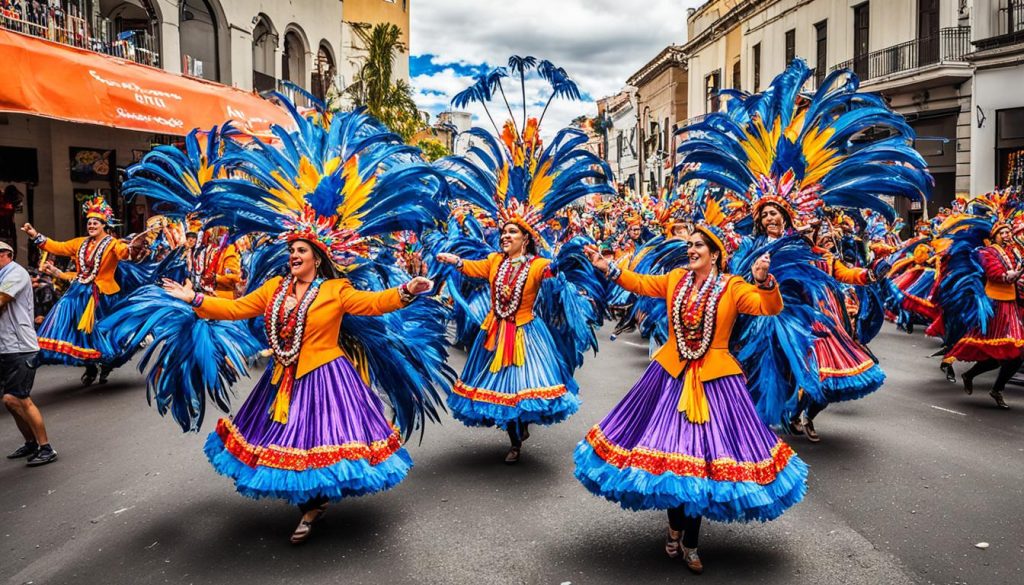South America welcomes travelers with open arms and a rich cultural tapestry. It’s known for samba spectacles in Rio de Janeiro1 and Inca celebrations in Cusco1. These events highlight the region’s diverse heritage, making each visit memorable.
Don’t miss the chance to taste Lima’s mouthwatering dishes or dance through Buenos Aires’ tango-filled streets1. And let’s not forget about exploring the awe-inspiring Patagonia. This journey will surely immerse you deeply in South America’s energetic and rich cultural scene.
Key Takeaways
- Discover the vibrant festivals and cultural events that showcase South America’s rich heritage
- Explore the diverse cuisine and nightlife of the continent’s most captivating cities
- Experience the ancient traditions and indigenous rituals of South America’s indigenous communities
- Immerse yourself in the stunning natural landscapes and outdoor adventures throughout the region
- Witness the passion and energy of South America’s ethnic carnivals and community gatherings
Rio de Janeiro: Lively Samba Capital of Brazil
Get ready to dive into the beating heart of Brazil’s culture in Rio de Janeiro. This city is famous as the home of samba music. It also hosts the biggest and most amazing Carnival in the world every year in February2.
During Carnival, the city bursts to life with samba music, colorful parades, and millions of people dancing. It’s an unforgettable experience that shows the true spirit of Rio2.
Unique Festivals and Celebrations
Rio has a busy calendar full of diverse festivals and celebrations. From the well-known Carnival to unique events like the Festival of the Goddess of the Sea and Independence Day festivities, Rio knows how to party. This is a chance to see how the city celebrates its deep-rooted traditions with lots of fun and energy3.
Visitors can join in with the local’s dance rehearsals or see the making of the grand parade floats. This all leads up to the amazing Carnival, where you can feel the real excitement and vibrancy of Brazil2.
Iconic Sites like Christ the Redeemer and Copacabana Beach
Aside from the exciting festivals, Rio is known for its famous landmarks. The Christ the Redeemer statue is perched on Corcovado Mountain, overlooking the city. It’s a symbol of the city’s natural beauty and faith.
is another highlight, pulling in visitors with its golden sands and clear waters. Here, you can enjoy the Brazilian culture mixed with a relaxed beach vibe324.
Iguazú Falls: Natural Wonder on the Brazil-Argentina Border
Iguazú Falls sits on the border of Brazil and Argentina5. It’s well known for its amazing power and beauty. These falls push out 1,500 cubic meters of water per second. They cover 3 kilometers and have 275 cascades5. A lush, subtropical forest surrounds the falls6. The mist forms a beautiful place for many types of plants and animals. On sunny days, you can see lovely rainbows here.
Iguazú Falls’ Devil’s Throat is very impressive. This falls section is massive and U-shaped. It falls into a narrow chasm, creating an awesome sight6. Devil’s Throat is 150 meters wide and 80 meters high. It lets out 8,500 tonnes of water every second at its peak6. The rainforest around it holds 2,000 plant species and 450 bird species. Iguazú Falls is truly a magical place of nature6.
Exploring the Brazilian or Argentine side is a wonder for any South America visitor5. The wet season from December to March is the most crowded. The drier months from May to August bring cooler temperatures and fewer people5. But no matter when you go, this natural marvel will amaze you576.
Buenos Aires: The Paris of South America
Buenos Aires is often called the “Paris of South America” for good reason. It charms visitors with its European-style buildings and lively cosmopolitan life8. The city creates a rich blend of culture, drawing from Italy, England, and the United States8.
European-Inspired Architecture and Culture
The Recoleta area is perfect for a leisurely walk. La Boca, with its vibrant streets, shows off its Italian influence. You can also visit Plaza de Mayo for a taste of the city’s art culture8. Despite a tumultuous economic past, Buenos Aires shines bright and colorful8.
Tango Shows and Argentine Asado
Don’t miss a tango show in Buenos Aires. They’re passionate and unforgettable. Afterward, enjoy an Argentine barbecue and wine8. The city offers a variety of entertainment, from hip-hop to jazz, showing its dynamic nature8.
Buenos Aires doesn’t fit neatly into just one category. It’s always changing, welcoming new things. The city’s street life is vibrant, with kids playing everywhere and spontaneous dance parties8.

The city stands out in many ways, making comparisons hard. It’s proud of what makes it unique8.
| Statistic | Value |
|---|---|
| Population | 2,891,0829 |
| Italian Heritage | Over 62.5%9 |
| Cost of Lunch | $59 |
| Number of Parks | Over 1009 |
| Milongas per Night | 20-309 |
| Bookstores per Person | Most in the world9 |
| Recoleta Cemetery | Most important in Latin America9 |
| Avenida 9 de Julio | Widest avenue in the world9 |
| Japanese Garden | Largest outside Japan9 |
| Subway System | Oldest in Latin America9 |
| Gay Marriage | First legalized in Latin America9 |
Known as the “Paris of South America,” Buenos Aires has a complex past and mix of people10. Most of its residents are of European descent, giving it a European feel. But, there’s also a strong Afro-Argentine influence, though they’ve often been left out10. Organizations like Afrohunting work to celebrate this mix and create unity among Afro-Argentines10.
“Buenos Aires is a city that constantly reinvents itself, defying any attempt to pigeonhole it into a single identity. It is a vibrant, youthful, and dynamic place that welcomes new ideas and ventures with open arms.”
Lima: Culinary Capital of Peru
Lima is on Peru’s Pacific Coast, known for its food. It’s famed for fresh seafood and mixes traditional Peruvian dishes with international flavors. This includes tasty ceviche and cool pisco sours11.
In Miraflores, you can enjoy incredible views and check out the amazing Parque del Amor. Here, you can also learn how to make ceviche from skilled chefs11.
Don’t forget to try a pisco sour when in Lima. It’s a unique cocktail with pisco, lime, and egg white. Lima’s food combines local traditions with flavors from Europe, Asia, and Africa11.
Ceviche and Pisco Sours on the Pacific Coast
Lima’s food scene shows off Peru’s diverse cuisine. Events like the Mistura food festival and La Vendimia wine festival celebrate its gastronomic heritage1112.
As the culinary capital of Peru, Lima is a place to enjoy world-famous Peruvian food. Taste amazing ceviche and well-made pisco sours. The city’s food culture promises an unforgettable experience11.
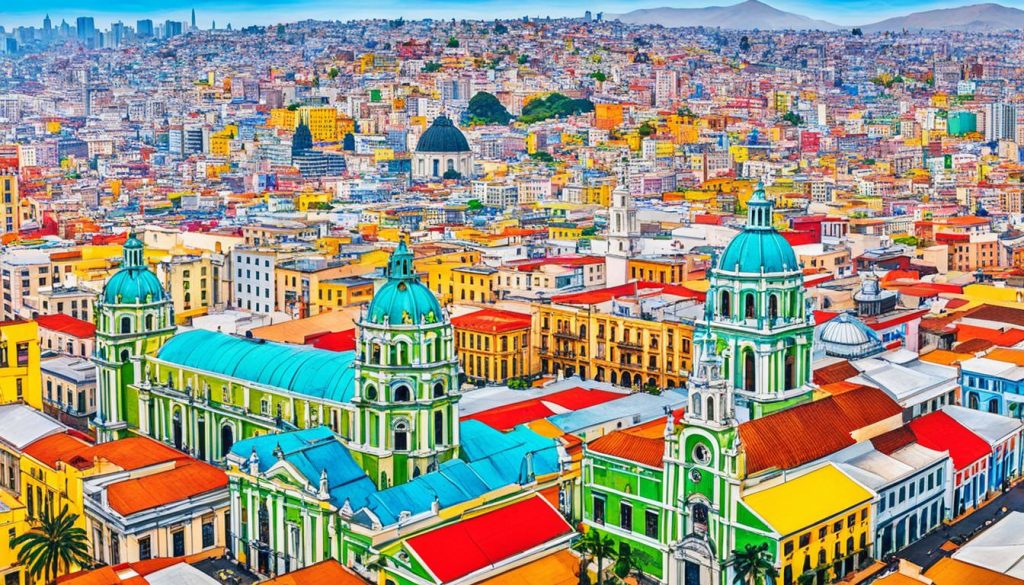
“Peru’s cuisine is one of the most diverse in the world, a reflection of the country’s complex history and geography.” – Anthony Bourdain
Cusco: Ancient Inca Capital and Gateway to Machu Picchu
High in the Andes Mountains is Cusco, at 11,150 feet (3,400 meters) above sea level. It was the mighty capital of the Inca Empire. Dating back to the 11th or 12th century, this city was the heart of an empire with over 12 million people before the Spanish arrived13.
Now, Cusco’s streets show off amazing Inca ruins. There are huge walls made of boulders at Sacsayhuaman. These boulders weigh up to 300 tons and are 27 feet tall13.
The city mixes Spanish colonial architecture with the Inca legacy. The Convent of Santo Domingo stands on the Inca temple of Koricancha13. Walking in Plaza de Armas, you’ll see Cuzco Cathedral. It uses stones from Sacsayhuaman and mixes Inca themes with Catholic design13.
Cusco is known for making cloth, rugs, and tapestries. They also produce fine metalwork and beer, for both locals and visitors13. The city’s people are mainly Indian and mestizo. This shows Cusco’s rich mix of cultures13.
As the entrance to Machu Picchu, Cusco is well-linked by rail and road. This connects it to nearby towns like Pisaq and Ollantaytambo13.
Cusco is a special place that mixes Inca heritage with Spanish influence. It stands out as a must-see in South America, whether you’re looking at the old ruins, the colonial architecture, or getting ready to visit Machu Picchu1415.

“Cusco, the ancient capital of the Inca Empire, is a UNESCO World Heritage Site. Today, it shows a mix of colonial Spanish buildings and amazing Inca ruins.” – Travel Guide
The Sacred Valley: Mystical Ruins and Landscapes
In the Andes mountains, you’ll find the Sacred Valley of the Incas. It’s a hidden gem leading to iconic Machu Picchu16. This Valley was vital for agriculture, trade, and defense in the Incan Empire. It’s not just a gateway to Machu Picchu; it has its own stunning ruins and landscapes17.
Exploring the Inca Trail and Inca Ruins
The legendary Inca Trail offers a deep dive into Inca history and culture16. As you trek, you’ll see Pisac and Ollantaytambo’s incredible stonework16. Fields in the Valley helped feed the Incan people, creating a breathtaking sight16.
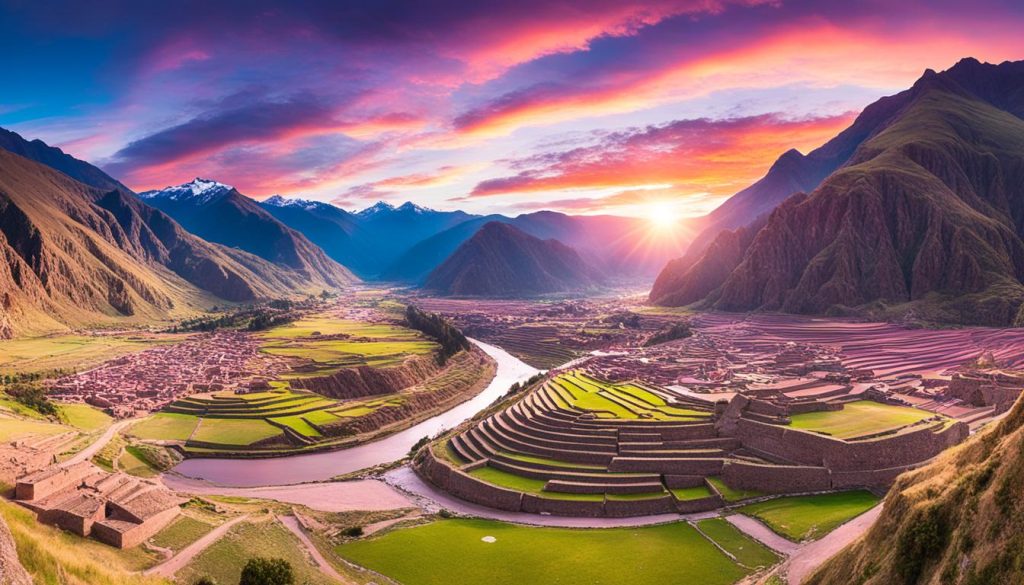
Alpaca Expeditions, a Peruvian company, is key in Cusco’s tourism. It links visitors closely to the Sacred Valley and its communities16. This company’s work with locals for traditional tours shows a focus on sustainable tourism16. Their tours include visits to Pisac, Ollantaytambo, Chinchero, and Cusco. You’ll meet local artists and see traditional crafts16.
Try the Valley’s local food like ceviche and “cuy” (guinea pig) to see its culinary blend16. Alpaca Expeditions promotes responsible tourism. They support local shops and keep traditions alive16.
“The Sacred Valley is a place of mystical beauty, where the past and present converge in a tapestry of ancient ruins, vibrant cultures, and breathtaking landscapes.”
The Valley’s terraced fields and ancient ruins immerse visitors in Andean heritage161817.
Machu Picchu: Lost City of the Incas
High in Peru’s Andes mountains sits Machu Picchu, the lost city of the Incas19. It was built in 1450 AD and is now a UNESCO World Heritage Site19. This place shows how an ancient culture lived and thrived in this area.
At 2,430 meters above sea level, Machu Picchu is an impressive sight19. It was left behind in 1572 when the Spanish came19. The area it covers is huge, about 38,160.87 hectares. It was forgotten until 1911 when Hiram Bingham, an American explorer, found it. Now, it is known worldwide for its beauty and history.
When Machu Picchu was at its peak, it was home to about 750 people, many from different places19. They mainly grew crops on terraces. These terraces covered almost 4.9 hectares of land. Even if they didn’t produce enough food, the area around brought the rest19.
Today, Machu Picchu is an important place for visitors from all over the world. People are working to keep it in good shape and make sure visitors don’t harm it20. This way, it continues to show the smartness and strength of the ancient Inca people.
“Machu Picchu is one of the most beautiful and enigmatic ancient sites in the world.” – Hiram Bingham, Explorer
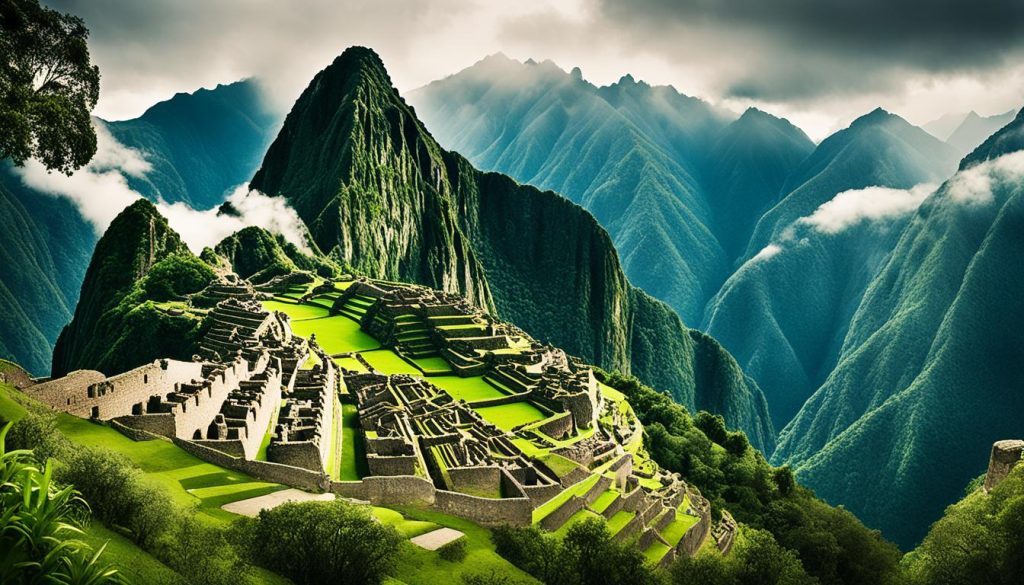
If you want to learn about the Inca Empire, visiting Machu Picchu is a great idea. You can walk the Inca Trail or take a tour to see the ruins20. This place will amaze you and help you understand the great culture of South America192021.
The Amazon: Rainforest Adventures and Indigenous Culture
Step into the deep, green world of the Amazon. This rainforest in South America lets you dive into eco-tourism. You’ll learn a lot about the people and nature here22.
Eco-Tourism and Wildlife Spotting
Begin an adventure in the Amazon’s heart. Travel its rivers, hike through its green roof. See amazing animals like the macaw and jaguar. You’ll love the eco-tourism while learning to take care of this precious place22.
Meet the groups living here for ages. Join in at Indigenous festivals to see their unique life. You’ll see their art and learn about their ways. It’s a chance to get to know the Amazon better22.
Help keep their traditions alive. People work hard to save their ways for the future. They teach others and make sure their culture is not lost22.
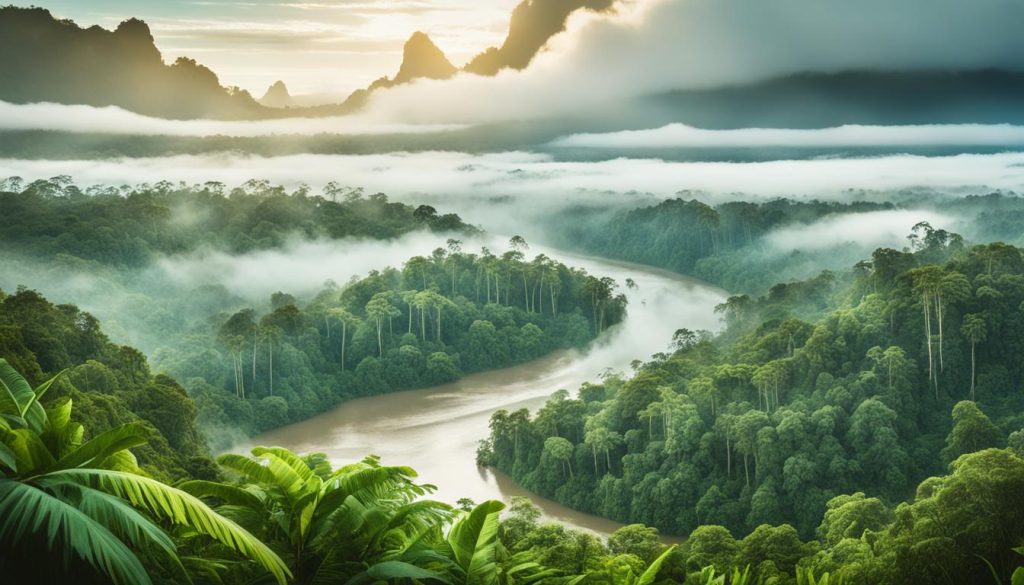
The Amazon’s balance is getting hurt. Big cities, cutting down trees, and change are tough on the locals. But education and tech help to keep their stories alive22.
Join the Amazon’s eco-tourism and cultural fun. Nature meets people in a beautiful way here. Discover the Amazon’s amazing story and help keep it safe22.
| Amazon Rainforest Festivals | Date | Highlights |
|---|---|---|
| Anniversary of the City of Iquitos | January 5 | Typical dances, craft fairs, and painting exhibitions23 |
| Second Indigenous Carnival | February 8-10 | Dances, typical dishes, and crafts of the Loreto indigenous people23 |
| International Festival of the River Wolf | May 21-27 | Awareness campaigns, training, and contests highlighting Amazonian wildlife23 |
| Anniversary of Manu National Park | May 29 | Dance contests, ecological trotting, and sports championships to promote biodiversity preservation23 |
| San Juan Festival | June 23-25 | River purifications, processions, music, and traditional rituals23 |
| Anniversary of Puerto Maldonado | July 10 | Competitions, tastings, and beauty queen elections, blending civic celebrations with local traditions23 |
| Sine Do End Dari Festival | September 17-23 | Dance contests, food exhibitions, and ritual ceremonies that represent the bond between communities and their land23 |
| Tourism Week in Iquitos | September 23 – October 2 | Gastronomic festivals, sports competitions, and tourist walks to promote the regional beauty23 |
| Ecological Tourism Week | Starting September 25 | Art contests and tourist awareness talks to advocate for conservation and sustainable tourism23 |
| Anniversary of the Department of Amazonas | November 21 | Civic, cultural events, and parades showcasing the region’s diversity and fostering local patriotism23 |
| Anniversary of Madre de Dios | December 26 | Evenings, serenades, and Christmas parades that merge holiday joy with local identity celebrations23 |
The Amazon is all about its people and their traditions. Meet the Baniwa and see the young in their special clothes. It’s a chance to understand and admire their culture24.
“Every tree lost signifies a loss of ancestral lands, stories, and medicines.”
Saving the ways of these people is very important. They are working with others to protect their rights and way of life. Let’s help keep their culture alive the right way24.
From big parties to important work, the Amazon is full of adventure. Come and be part of the story. Nature and humans together here make a beautiful story222324.
Unique Festivals: Vibrant Celebrations across South America
South America is like a beautiful patchwork quilt, full of unique cultures and their own special traditions. The Carnival of Rio de Janeiro is one of the biggest parties, with over two million people celebrating each day25. On the other side, in Peru, the Inti Raymi festival lasts for nine days25. It lets you dive deep into ancient traditions.
In Mexico, the vibrant Día de los Muertos mixes Aztec and Catholic customs26. This unique mix results in a colorful and meaningful celebration. Moving to Belize, the Chocolate Festival combines the local cacao scene with ancient Maya traditions26. In Colombia, the Feria de los Flores showcases bright blooms with concerts and more.
South America has plenty of traditional events that captivate. In Bolivia, there’s a fascinating festival that focuses on American Renaissance and Baroque Music, happening only in even years in May25. A bit further, on Easter Island, Chile, the Tapati Festival offers various games and cultural displays in a single day25.
In Argentina, November hosts the Traditional Festival of San Antonio de Areco, spotlighting the area’s famous gauchos25. In Peru’s Puno, the Fiesta de la Virgen de la Candelaria mixes Catholic and Indigenous culture by Lake Titicaca, known as Peru’s largest gathering by UNESCO26.
The rhythmic beats of Carnival or the mystical rituals of South America’s Indigenous communities are mesmerizing27. The continent’s diverse festivals offer a special way to explore its rich culture and traditions, ready to enchant anyone27.
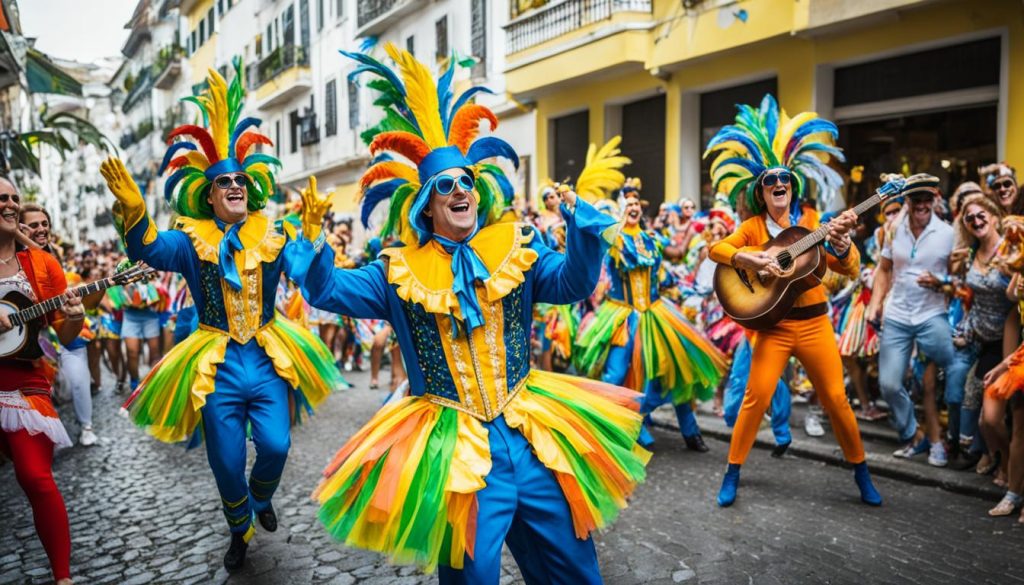
| Festival | Location | Date | Description |
|---|---|---|---|
| Carnival of Rio de Janeiro | Rio de Janeiro, Brazil | February 28th – March 5th, 202527 | The world’s largest and most famous festival in South America, with over two million people attending each day25. It is celebrated for several days leading up to Lent27. |
| Barranquilla Carnival | Barranquilla, Colombia | March 1st, 202527 | A vibrant celebration showcasing the cultural heritage and traditions of Colombia. |
| Tapati Rapa Nui | Easter Island, Chile | February (specific date not provided)27 | A festival featuring athletic competitions and cultural celebrations on the remote Easter Island. |
| Inti Raymi | Cusco, Peru | June 24th27 | A nine-day festival celebrating the sun god, Inti, in the ancient Inca capital25. |
| Oruro Carnival | Oruro, Bolivia | February 28th – March 5th, 202527 | A vibrant celebration showcasing the cultural heritage and traditions of Bolivia. |
| Fiesta de la Virgen de la Candelaria | Puno, Peru | February 2nd27 | A festival that blends Catholic and Indigenous traditions by the shores of Lake Titicaca, recognized by UNESCO as Peru’s largest festival26. |
| Festival of the Flowers | Medellín, Colombia | August 2nd – 11th, 202427 | An annual celebration showcasing the floral abundance and vibrant culture of the region. |
| Quito Festival | Quito, Ecuador | November 29th, 202427 | A festival that celebrates Semana Santa (Holy Week) with significant processions through the streets. |
| Oktoberfest | Brazil and Argentina | October27 | A celebration of German heritage and culture, with festivities taking place in various parts of Brazil and Argentina. |
| Festival Nacional de la Doma y el Folklore | Jesús María, Argentina | January 10th – 19th, 202527 | A festival that showcases the traditions and folklore of Argentina, including the iconic gauchos. |
South America’s cultural assortment shines through colorful, vibrant gatherings26. From dazzling Carnivals to deeply rooted traditions, each festival invites you to explore the continent’s richness25. No matter what you’re looking for, South America’s festivals provide a delightful peek into its varied heritage26.
Santiago: Modern Metropolis Meets Andean Landscapes
In the shadows of the Andes lies Santiago, a mix of tall buildings and deep culture. Being Chile’s biggest city, it’s home to over 7.1 million people. That’s about 40% of Chile’s whole population28. This energetic city is known for both its economy and culture and sits 500-650 meters above the sea28.
Exploring Santiago means seeing various architecture styles. You’ll find Neoclassical beauty at the Plaza de Armas and Metropolitan Cathedral. Or, gaze upon the city’s skyline marked by modern buildings29. The districts like Bellavista and Lastarria mix old historical buildings with vibrant markets and street art29.
But, beyond its cityscape, Santiago is a hub for culture. It hosts festivals displaying the local food, music, and dance29. Take a food tour to taste Chilean favorites like empanadas and Pastel de Choclo. Or, enjoy live music at the many festivals and venues29.
For lovers of art, Santiago has top-notch museums. The Museo Nacional de Bellas Artes and the Museum of Memory and Human Rights highlight the nation’s art and history29. The city is also known for its modern and green architecture, making it a smart and lively place to visit29.
Whether it’s the mighty Andes mountains, the rich culture, or the mix of the old and the new, Santiago is a spot you can’t miss. It’s sure to leave a mark on your heart30.
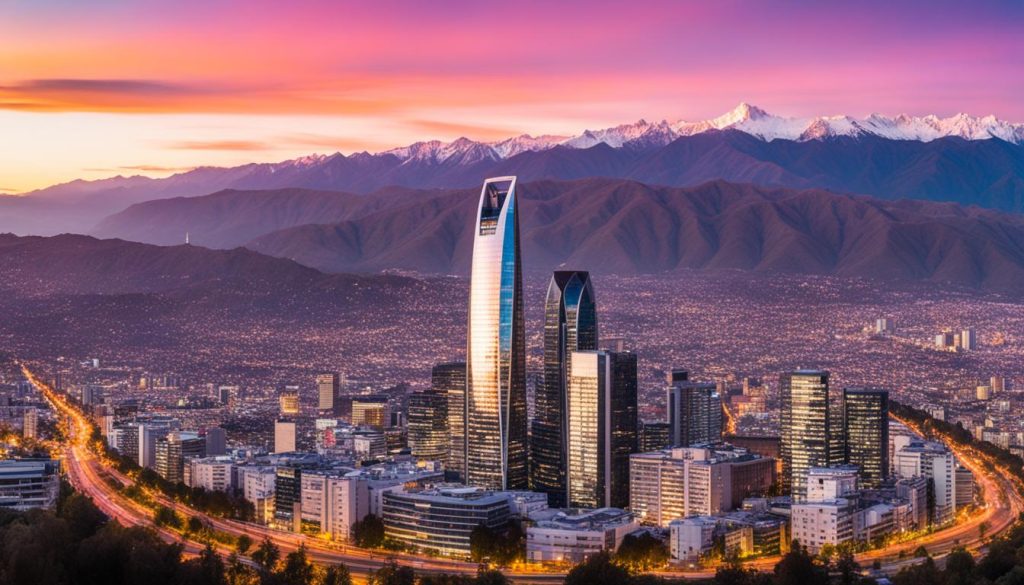
Ushuaia: The World’s Southernmost City
Tucked at the tip of South America, Ushuaia, Argentina, is an amazing city31. It’s the starting point to the beautiful Tierra del Fuego and Antarctica. Being the world’s southernmost city gives Ushuaia a special pull that attracts people worldwide32.
Gateway to Antarctica and Tierra del Fuego
Located by the Beagle Channel, Ushuaia is close to Tierra del Fuego National Park. Here, you can see wild landscapes with mountains, glaciers, and interesting animals32. The Maritime Museum shows off the area’s sea history. Plus, it’s a place where trips to Antarctica begin32.
The best time to visit Ushuaia is in summer, from October to March31. This is when the weather is best and daylight lasts longer. But you can also visit in winter, from April to September, for fewer people and cheaper stays31.
| Month | Average Temperature | Rainfall Days | Hotel Costs |
|---|---|---|---|
| January | 10°C/50°F | 10 | High |
| February | 10°C/50°F | 8 | High |
| March | 9°C/48°F | 12 | Moderate |
| April-August | N/A | 14-17 | Varies |
| May-June | N/A | N/A | Lowest |
| January, February, December | N/A | N/A | Highest |
Around 70,000 people call Ushuaia home, and it’s full of life with tourism and industry32. The city’s airport has flights within Argentina daily and to Chile weekly. This makes it easy to start your journey in the area. During summer, buses also connect Ushuaia to nearby places32.
There’s much to do in Ushuaia, like hiking in the park, taking Beagle Channel cruises, and doing winter sports32. It hosts events like the Ushuaia International Film Festival in April and the Ushuaia Longest Night Festival in June31.
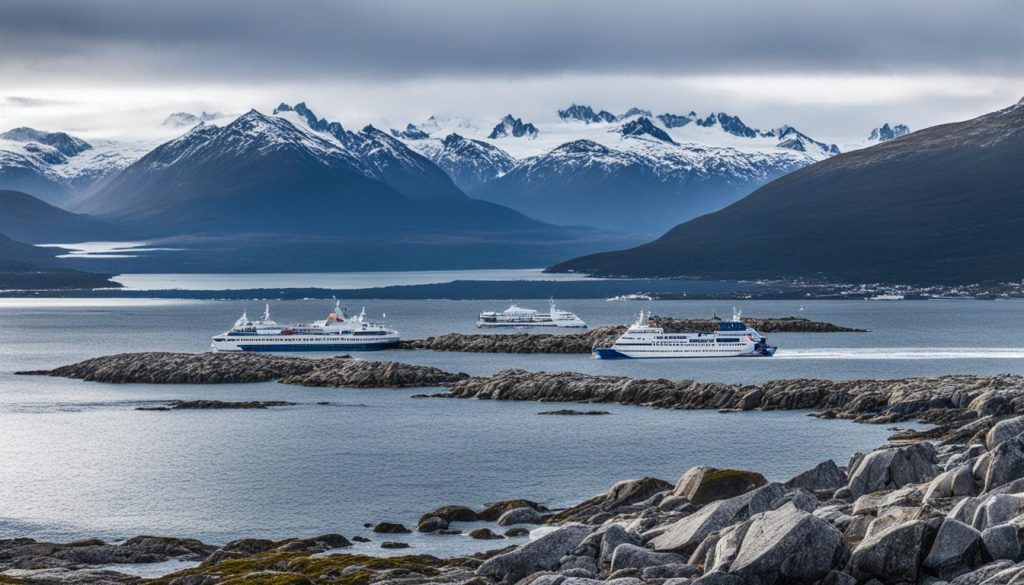
In 2024, Ushuaia marked its 140th year with the EMUSH 2024 event33. This festival had 11 artists, focusing on mural art. One artist came from Brazil. AkzoNobel, a big paint brand, gave paint for the artworks. The event added more art to the city, making it even more beautiful33.
There’s now over 300 murals in Ushuaia, making its art scene very special33.
“Ushuaia is a city that truly captures the essence of the southernmost reaches of South America, offering unparalleled access to the natural wonders of Tierra del Fuego and Antarctica. Its rugged beauty, rich history, and diverse cultural offerings make it a must-visit destination for any traveler seeking an unforgettable adventure.”
Ushuaia is perfect for those who love nature, history, and culture. It’s a special city, being the farthest south in the world. It shows the beauty and adventure waiting for those who explore the earth’s extremes.
San Pedro de Atacama: Desert Oasis and Stargazing Haven
In the northeast of Chile lies San Pedro de Atacama, a stunning oasis in the Atacama Desert34. This town is found 2,408 meters above sea level34. It’s surrounded by amazing places like Valle de la Luna with its unique rocks and sandy dunes. You’ll find this area great for exploring the desert’s natural beauty.
San Pedro de Atacama is famous for its clear night skies35. Half of the world’s ground-based astronomy happens here35. It has more stargazing tours than the popular Elqui Valley nearby35. You can join special star tours with SPACE, a group that has the biggest public telescope park in South America35.
Besides stargazing, San Pedro de Atacama offers many more amazing sights36. It’s known for places like Valle de la Luna, Salar de Atacama, and El Tatio’s geysers at 4,320 meters high34. You can also visit hot springs, volcanoes, and more. It’s truly an oasis and a top spot to see in South America.
Stargazing in the Atacama Desert and Guide to the Atacama Desert provide detailed info. For a unique view, check out San Pedro de Atacama: A Hippie and Wild.
“San Pedro de Atacama is a place where the earth meets the sky, where the desert blends with the stars, and where the human spirit is humbled by the sheer magnitude of nature’s grandeur.” – Ariadne Nardeli, travel writer
Sao Paulo: Culinary and Nightlife Capital of Brazil
Sao Paulo is the largest city in South America. It’s alive and diverse, offering many cultural things to do37. The city is famous for its great food scene and parties at night. It’s also a center for art, beautiful buildings, and new food ideas38.
There are many parts of the city to see. For example, Jardins has cool hidden places to eat and little theaters. And Sao Paulo has over 15,000 places to get drinks at night39.
Sao Paulo is a mix of many cultures, like German and Japanese. This mix makes the city very special and interesting. It hosts many fun events and festivals that show its diverse culture37.
Places like Avenida Paulista and Ibirapuera Park are must-sees. Sao Paulo is exciting and has a lot to offer. Its art scene is full of top galleries and the famous Sao Paulo Art Biennial38.
The city’s food scene is amazing, some say it’s the best in Brazil. You can find everything from traditional foods to new, creative snacks. The nightlife in areas like Vila Madalena is buzzing. It makes Sao Paulo a top spot for anyone wanting a memorable visit39.
Sao Paulo is great if you love history, art, food, or just having fun at night. This city will stay with you long after you leave373839.
| Sao Paulo’s Iconic Events and Festivals | Description |
|---|---|
| Virada Cultural | A 24-hour cultural festival with over 2,000 music acts37 |
| Sao Paulo Fashion Week | An important fashion event since 1995, bringing in top models37 |
| Brazilian Formula 1 Grand Prix | An annual race at Interlagos for Formula 1, welcoming 80,000 fans37 |
| Sao Paulo International Film Festival | Known as the Mostra, it shows indie films at different places37 |
| Sao Paulo Gay Pride Parade | One of the biggest pride parades, with a huge crowd37 |
| Carnaval in Sao Paulo | A famous week of parties, with a big parade at Sambódromo37 |
The city shines with its lively events, amazing food, and fun nights out. Sao Paulo is a gem in South America that’s not to be missed373839.
Paramaribo: Dutch-Influenced UNESCO World Heritage Site
In the northeast part of South America sits Paramaribo, the capital of Suriname. This city mixes Dutch colonial history with lively indigenous cultures40. With about 241,000 residents, it boasts a blend of old colonial architecture and modern life40. Its location by the Suriname River enhances its beauty and was recognized by UNESCO in 200241.
Rainforest Tours and Indigenous Culture
Paramaribo also acts as an entrance to the Surinamese rainforests40. There, visitors can learn about the local indigenous people through guided tours and activities41. Exploring places like the Galibi Nature Reserve or the Suriname River lets you see traditional villages and wildlife41.
The city’s food reflects its mix of cultures with dishes from Creole, Hindustani, Javanese, and Chinese traditions41. A visit to the Central Market by the Waterkant is a must. Here, you can try local foods and feel the city’s energy40.
Paramaribo stands out with its old buildings, like the Saint Peter and Paul Cathedral. This cathedral is a large wooden structure known in the Western Hemisphere40. Other sites like Fort Zeelandia tell stories about Suriname’s Dutch history40.
Are you interested in the Dutch history, the indigenous cultures, or the natural rainforests? Paramaribo is full of things to do. Its charm is perfect for unforgettable memories40. The best time to go is during the dry season from August to November40. This is when the Suriname Jazz Festival happens. You can also enjoy outdoor events and river tours40.
If you’re after a unique cultural experience or a nature adventure, Paramaribo is ideal40. Its mix of Dutch and local influences makes it a top destination in South America40.
El Calafate: Hiking Hub for Patagonia’s Glaciers
El Calafate is a charming town on the edge of the Southern Patagonian Ice Field. It’s well-known for its beautiful glaciers and stunning landscapes in the Patagonia region. This town is the starting point for seeing the incredible Perito Moreno Glacier, which is rare because it’s still growing42.
The Perito Moreno Glacier is a huge ice formation covering 250 square kilometers. It’s 30 kilometers long and a real natural wonder in Argentine Patagonia42. Here, you can hike, visit a museum about the ice, and enjoy the glorious scenery that draws outdoor lovers to Patagonia42.
- Explore the Perito Moreno Glacier up close with options like the Minitrekking tour (about 1.5 hours) or the more challenging Big Ice tour (about 3.5 hours)42.
- See how special the Perito Moreno Glacier is, growing as much as 2 meters a day. Most glaciers are getting smaller, not bigger42.
- At the Glaciarium Patagonian Ice Museum, learn about how these stunning ice structures form and the science behind them42.
- https://tunekong.com/diy-home-decor-masterclass-transform-any-space-with-simple-stunning-ideas-16/
A visit to El Calafate and the Perito Moreno Glacier is essential to experiencing the beauty of Patagonia. El Calafate is quickly becoming a key spot for tourists wanting to explore the incredible landscapes of Los Glaciares National Park42. The perfect time to go is from December to February, the summer season and when most people visit42.
“Visiting Perito Moreno Glacier is a must-do experience, being one of the best places to visit in Argentina and a popular tourist attraction in the country.”
Getting ready for your El Calafate trip means knowing about the entrance fee. Non-residents pay about ARS$12,000 to enter Los Glaciares National Park, paid in cash42. The tours to the glacier can also be quite pricey, from around US$300 to US$530, including transportation42.
El Calafate has more to offer than just the Perito Moreno Glacier. You can see pink flamingoes at Lago Argentino, learn about glaciers at the Glaciarium, and even have a drink at an ice bar. Biking around the area is another fun option42. With about 8,000 people, El Calafate buzzes with outdoor and nature enthusiasts. It’s a perfect place to start exploring the magnificent Patagonia43.
If you love hiking, glaciers, or natural beauty, don’t miss El Calafate and the Perito Moreno Glacier on your travels. You’ll be amazed by the stunning views and the chance to see one of the world’s few growing glaciers.
Conclusion: Exploring South America’s Diverse Cities
South America’s cities are full of cultural experiences and natural wonders. Rio de Janeiro has lively samba festivals44, while Cusco celebrates its ancient Inca roots44. Food lovers will enjoy Lima’s dishes, and Buenos Aires offers a taste of tango. Then there’s the stunning beauty of Patagonia. All are rich in traditions and unique celebrations45.
The continent spans over 17.84 million square kilometers46, offering a mix of landscapes. From the Andes Mountains46 to the Amazon Rainforest’s greenery46, it’s a feast for the eyes. Travelers will find art that bursts with color and ancient ruins45. No matter what you like, South America invites you to explore and be amazed.
South America’s cities vary from busy Rio to quiet Patagonia. They are a blend of cultural richness and natural beauty. By joining in on local festivals, admiring indigenous art, and seeing the views, you’ll truly get to know this vibrant continent. So, get your bags ready. This journey through South America’s diverse cities is about to begin.
FAQ
What are some of the unique festivals and cultural celebrations in South America?
South America dazzles with colorful and lively festivals. For instance, Rio de Janeiro hosts samba festivals that are full of energy. In Cusco, ancient Inca celebrations take place. You’ll also find ethnic carnivals, regional fairs, and folk festivals. Each event tells a story of the area’s heritage.
What are the must-visit cities in South America?
Key cities in South America such as Rio de Janeiro and Buenos Aires draw millions. Lima and Cusco offer unique cultural experiences. Experiences in Santiago, Ushuaia, and San Pedro de Atacama are also noteworthy. Don’t miss Sao Paulo and Paramaribo for their local festivities.
What makes Rio de Janeiro a popular destination in South America?
Rio de Janeiro buzzes with samba music and hosts the famous Carnival. During Carnival, you can see parade floats and join in the fun. It’s also home to landmarks like the Christ the Redeemer statue and Copacabana Beach.
Why is Iguazú Falls a must-see natural wonder in South America?
Iguazú Falls sits at the border of Brazil and Argentina. It’s made up of 275 falls in a dense forest. The falls’ mist creates rainbows on sunny days. It’s a natural wonder that’s a must-see.
What makes Buenos Aires the “Paris of South America”?
Buenos Aires charms with its European flair and lively culture. The Recoleta neighborhood and La Boca’s colorful streets are inviting. Plaza de Mayo and tango shows offer a glimpse into Argentine culture.
What culinary delights can be found in Lima, Peru?
Lima is famous for its seafood and Peruvian cuisine. It’s where you should try ceviche and the pisco sour. The city’s culinary scene is vibrant and full of flavor.
What is the significance of Cusco in the Inca Empire?
Cusco was the capital of the Inca Empire. It mixes Spanish and Inca ruins beautifully. Key sites include Sacsayhuaman, Santo Domingo, and the Plaza de Armas.
What can visitors experience in the Sacred Valley of the Incas?
The Sacred Valley heads to Machu Picchu and has its own wonders. It’s a trail of mystical ruins and scenic beauty. The Inca Trail offers a look at ancient Inca life.
Why is Machu Picchu considered one of the most iconic destinations in South America?
Machu Picchu is a symbol of Inca civilization in the Andes. This lost city fascinates with its ruins. It’s a UNESCO site rich in history and culture.
What unique experiences can travelers have in the Amazon rainforest?
The Amazon hosts rich biodiversity and cultural traditions. Eco-tourism allows for a deep jungle and wildlife experience. It’s a chance to learn about the Amazon’s native people.
What other unique cultural destinations and festivals can be found in South America?
South America is rich in diverse and lively cultural events. These include indigenous rituals, ethnic carnivals, and more. They offer a look at the continent’s spirit and variety.

